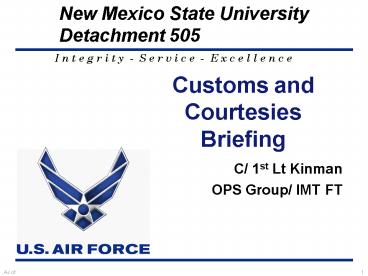Customs and Courtesies Briefing - PowerPoint PPT Presentation
1 / 13
Title:
Customs and Courtesies Briefing
Description:
... as appropriate 'Good morning (afternoon or evening) ladies and (or) gentlemen) ... females (time of day appropriate) as, 'Good evening ladies; good evening sir. ... – PowerPoint PPT presentation
Number of Views:207
Avg rating:3.0/5.0
Title: Customs and Courtesies Briefing
1
Customs and Courtesies Briefing
- C/ 1st Lt Kinman
- OPS Group/ IMT FT
2
Introduction
- Greeting
- Saluting
- 7 Basic Responses
- Reporting in Procedures
- Coming to Attention
- Traveling in Groups during LLAB
3
Greetings
- Use appropriate military courtesies when greeting
military members. Always use full rank and last
name if you recognize the member or by Sir or
Ma'am as appropriate. You will be required to
greet all POC, officers, and NCOs, both inside
and outdoors during LLab. - Practical
- (1) Good morning, Lieutenant Colonel Allen.
- (2) Good afternoon, Cadet Cheng.
- (3) Good evening, Technical Sergeant Smith.
- (4) Greet groups of officers as appropriate,
Good morning (afternoon or evening) officers
4
Greetings
- (5) Greet groups of NCOs as appropriate Good
morning (afternoon or evening) ladies and (or)
gentlemen). - (6) Greet mixed groups (officers, POC, NCOs,
males, females) appropriately as ladies and (or)
gentlemen. - (8) Greet groups of one female and multiple males
(time of day appropriate) as, Good morning
maam good morning gentlemen. - (9) Greet groups of one male and multiple females
(time of day appropriate) as, Good evening
ladies good evening sir.
5
Saluting
- A common military hand salute consists of raising
the right hand, held flat, to the right eyebrow.
The hand is slightly tilted forward, as if
shading the eyes so that the palm is not visible
to the one being saluted. - If passing by a senior ranking member a salute is
rendered 6 to 12 paces away from the senior
person. You will hold your salute until the
person has passed or returns the salute. The
salute is accompanied with an appropriate
greeting. However if both hands are full, only a
verbal greeting is rendered.
6
Saluting
- If in formation the commander will give a salute
for the entire group. - Practical Situations
- If you are in double-time is a salute required?
- Do you salute in the Physical Training Uniform?
- How does the guidon bearer perform a hand salute?
7
7 Basic Responses
- During LLab, when talking to POC you will be
required to STAND at the position of attention
and use 7 basic responses, unless otherwise told
differently. - (a) Yes, Sir (Maam).
- (b) No, Sir (Maam).
- (c) No excuse, Sir (Maam).
- (d) Sir (Maam), I do not know.
- (e) Sir (Maam), I do not understand.
- (f) Sir (Maam), may I make a statement?
- (g) Sir (Maam), may I ask a question?
8
Reporting in procedures
- If you have been directed to report, you will
state, Sir (Maam), Cadet (last name) reports as
ordered. - If reporting on your own, you will state
appropriately - (a) Sir (Maam), Cadet (last name) reports to
ask a question. - (b) Sir (Maam), Cadet (last name) reports to
make a statement. - When reporting to an officer in his/her office,
knock twice on the door. When told to enter, walk
directly (squaring any corners) to within two
paces of the desk, come to attention (eyes caged
forward), and salute. Hold your salute until it
is returned and remain standing at attention
until you are dismissed or told to be seated.
9
Reporting in procedures
- At the end of the conversation ask, Will that be
all, Sir (Maam)? The officer will acknowledge
then from the same location you reported in,
salute and state Good ( time of day) Sir(Maam)
10
Coming to attention
- If an officer (Army or Air Force) walks into or
out of a room, call the room to attention saying
Room tench hut. - If in uniform, and an officer (Army or Air Force)
is spotted near you (outside), call the area to
attention by saying Area, tench hut. Render a
salute and verbal greeting, and carry on. (this
applies to only groups of cadets. If you are by
yourself do not follow this procedure. Merely
salute and render a verbal greeting).
11
Coming to attention
- During Lead Lab you will be required to stand at
attention when speaking to a POC or an officer. - During Lead Lab, when entering a room, do not
talk, fill seats front to back, inside to
outside. When sitting you must sit at the
position of attention (feet at a 45 degree angle,
seated in the front 6 inches of your seat, back
straight, hands cuffed at your knees, eyes caged,
and no talking), unless told you can sit At
Ease.
12
Traveling in Groups during lab
- During Lead Lab, all GMC cadets will be required
to travel in groups. No GMC cadet should transit
alone. - Groups with two or more cadets will march two
abreast, keeping in step. - If a group has four or less members, the cadet in
charge will beat the right rear and all cadets
will render salutes. - If a group has five or more members, the cadet in
charge will march on the traffic side no more
than four paces from the unit, will salute for
the entire group, and will march even with the
last rank.
13
- Questions?































